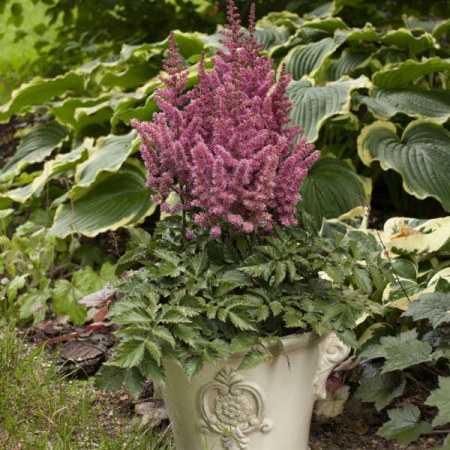Astilbe chinensis (Chinese Astilbe)
×
Color Name: Little Vision in Pink
Perfectly sized for containers or the front of the border. Little Vision in Pink offers all the same great traits as the original Vision in Pink but in a smaller package. Standing about 16 in bloom, a dense block of fuzzy, pyramidal shaped, rose pink plumes is presented just above the coarsely textured, dark green foliage in midsummer. Like all Chinese Astilbes, this one exhibits a bit greater tolerance to drier soils and can take full sun. A later blooming species useful for extending the bloom season into late summer. Foliage is deeply incised, coarsely textured, and often bronze-green in color. Flowers are borne on narrow, branched panicles. Though garden performance is far superior in moist soils, members of this species are moderately drought tolerant.
Growing Tips: Astilbes are long-lived perennials that are most comfortable when grown in rich soil and light shade to filtered sun. They will grow in full shade, but will not bloom as prolifically there. Though they are easy to grow, Astilbes have one critical requirement-lots of water. Plants must have consistently moist soil; dryness leads to a quick demise, especially in sun. Increase watering as the foliage emerges and the plumes mature. If the soil dries out, the leaves will develop brown, crispy margins and will begin to drop. Fertilize Astilbes in late spring before flowering starts. Wait to cut back the old foliage until spring; it will help protect the plant from winter damage. In the spring, if the crown has risen above soil level, gently press it back into the ground and apply some organic matter around the plant.
Photo courtesy of Walters Garden, Inc.
Perfectly sized for containers or the front of the border. Little Vision in Pink offers all the same great traits as the original Vision in Pink but in a smaller package. Standing about 16 in bloom, a dense block of fuzzy, pyramidal shaped, rose pink plumes is presented just above the coarsely textured, dark green foliage in midsummer. Like all Chinese Astilbes, this one exhibits a bit greater tolerance to drier soils and can take full sun. A later blooming species useful for extending the bloom season into late summer. Foliage is deeply incised, coarsely textured, and often bronze-green in color. Flowers are borne on narrow, branched panicles. Though garden performance is far superior in moist soils, members of this species are moderately drought tolerant.
Growing Tips: Astilbes are long-lived perennials that are most comfortable when grown in rich soil and light shade to filtered sun. They will grow in full shade, but will not bloom as prolifically there. Though they are easy to grow, Astilbes have one critical requirement-lots of water. Plants must have consistently moist soil; dryness leads to a quick demise, especially in sun. Increase watering as the foliage emerges and the plumes mature. If the soil dries out, the leaves will develop brown, crispy margins and will begin to drop. Fertilize Astilbes in late spring before flowering starts. Wait to cut back the old foliage until spring; it will help protect the plant from winter damage. In the spring, if the crown has risen above soil level, gently press it back into the ground and apply some organic matter around the plant.
Photo courtesy of Walters Garden, Inc.
|
Flower Color: Pink Shades Foliage Color: Green Shades
Height: 14 to 16 Inches Spread: 14 to 16 Inches Hardy in Zone: 4, 5, 6 |
Blooms: Mid-Summer
Foliage Season: All Season |
Growth Rate |
Medium
|
Attributes |
Fragrant Dried Flower Container Specimen Plant Mass Planting Landscapes Easy to Grow Border
|











